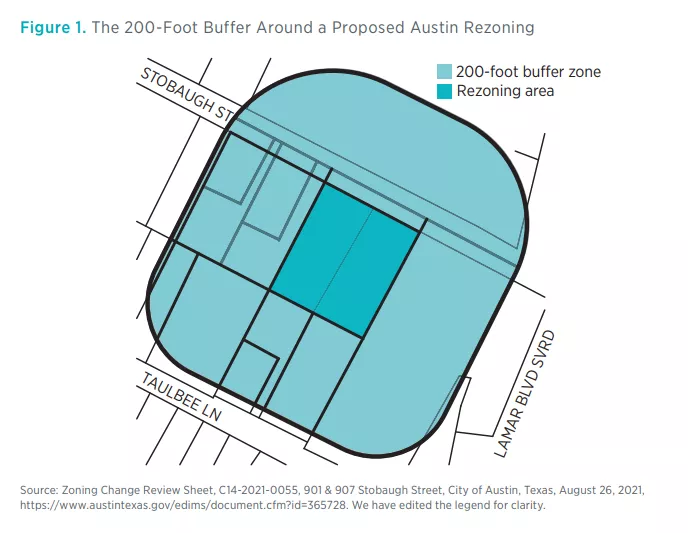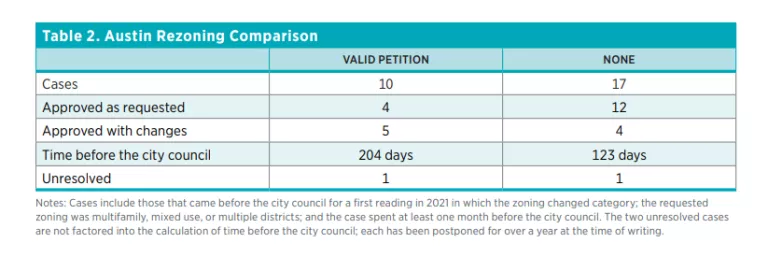- | Housing Housing
- | Policy Briefs Policy Briefs
- |
Mostly Invisible: The Cost of Valid Petitions in Texas
Legislators Ought to either Reform the Valid Petition Process To Be Less Onerous and More Democratic or Do Away With It Altogether
The Texas legislature is currently considering reforms to its valid petition law. Valid petitions are an obscure zoning procedure that have been used to try to obstruct a Dallas hospital expansion, student housing in Bryan, and Habitat for Humanity houses in Austin. The law has come under scrutiny as a potential contributor to the scarcity of housing—and thus its high cost. Legislators ought to either reform the valid petition process to be less onerous and more democratic or do away with it altogether.
Twenty states still have rezoning protest petition laws. Texas’ version is relatively strict, but the mechanics are the same as in other states: when a rezoning is proposed, the state must notify the owners of nearby land. In Texas, if owners of 20 percent of the land within 200 feet of a proposed rezoning site protest the rezoning, their protest constitutes a “valid petition.” Figure 1 shows a typical rezoning proposal, with the site and 200-foot buffer highlighted. Once a valid petition is filed, the city council can approve the rezoning only by a three-fourths supermajority. However, because of rounding, the margin is often higher; for example, if a city council is composed of seven members, six members (or 86 percent) must vote in favor. By contrast, Oklahoma’s moderate petition law only allows protests once owners of 50 percent of the land within a 300-foot buffer file an objection and allows such rezonings to pass with five yea votes from a seven-member council.
Texas’ valid petitions have been called “undemocratic” because the 20-percent rule gives an outsize voice to a few unhappy nearby landowners. Indeed, 5 of the 16 petitions in Dallas and Austin we examined could have been triggered by a single protesting neighbor’s signature. Furthermore, renters have no say in valid petitions.
Unlike in other states, Texas’ petition law now endangers citywide rezonings, thanks to a 2022 court opinion in City of Austin v. Acuña that blocked Austin from overhauling its own zoning (which was done to comply with its comprehensive plan, as paradoxically required under state law). In that case, a mere 1.4 percent of the city’s population was enough to force the supermajority at city council per the valid petition law. The court’s ruling jeopardizes future zoning overhauls in the Fourteenth Court of Appeals District and casts a shadow over any Texas city’s efforts to comprehensively rezone.

The power to alter city council voting thresholds lies with the legislature. Valid petitions implicitly delegate a substantial share of a city council’s power to a few private individuals. Their use of that power need not comply with the city’s comprehensive plan—and in fact often confounds it. And their use of that power is clearly in service of personal interests, not the public interest.
A bill filed by state Rep. Justin Holland, HB 1514, would increase the proportion of buffer area ownership share required for a valid petition from 20 to 50 percent. In the previous legislative session, HB 2989 (not enacted) would have reversed the court’s ruling, allowing valid petitions to apply only to limited, contiguous areas.
Valid Petition Capital of the World
There is no Texas-sized data source on the use of valid petitions, but even a cursory evaluation suggests that they are exceptionally frequent in Austin. For this policy brief, we read in detail two years’ worth of valid petitions from the city of Austin and 15 months’ worth from the city of Dallas. We interviewed seven development professionals from the Austin area. And we received information on the number of valid petitions filed in 2021 and 2022 from 10 other cities in North Texas (listed in table 1).
Twenty valid petitions were filed against Austin rezonings, but only three were filed in Dallas and four in the other 10 North Texas cities combined. Other data showed that rezonings are not exceptionally frequent in Austin, so that does not seem to explain the high incidence. Instead, we hypothesize that the capital’s well-organized neighborhood associations and City of Austin v. Acuña have raised awareness of valid petitions. Interviewees agreed that Austin is a valid petition hot spot, and two noted that 2020 and 2021 were especially active years for valid petitions. One accessory dwelling unit builder told us that a hostile neighborhood association convinced immediate neighbors to create a valid petition against his rezoning request, even though until then they did not personally oppose it.

Valid petitions are mainly used to block multifamily housing. In Austin, 25 percent of rezonings to a multifamily use faced a valid petition, compared to just 5 percent for commercial use. Our interviewees agreed that rezoning for multifamily housing was the likeliest to face a valid petition. In all the cases we read, valid petitions protested the loosening, not tightening, of land use regulations.
Invisible Impact of Valid Petitions
Valid petitions have a mostly invisible impact. Developers told us they have limited capacity, and thus they are less likely to invest time and money on a project that might fail to win city council approval. They tend to stick to sure things. One builder of starter homes shared how he speaks to neighbors before embarking on a project; if neighbors are opposed, he walks away. He estimates that half of his projects end at this stage. Once a project is green lighted, developers variously contact the neighborhood association, knock on doors, send letters, or hire consultants to pitch their plans to neighbors in hopes of heading off a fight.
Rather than risk a valid petition, few developers apply for rezonings in well-organized, affluent neighborhoods. Instead, we found that rezonings for multifamily development were concentrated on main roads; just 4 out of 28 were on local roads. Of the 24 multifamily rezonings on main roads, only 10 had sidewalks. Multifamily homes should ideally be within an easy walk of a park because they have little outdoor space on-site. But, instead, Austin’s regulatory norms shunt them to locations least appropriate for residences.
Most Austin interviewees agreed that valid petitions were a major barrier to development there. However, the city council’s public records are in apparent tension with this belief. Austin City Council strives for consensus, almost always making its rezoning votes unanimously. Professionals told us that the public consensus masks backroom debates and negotiations. Developers prefer to delay planning commission and city council votes until passage is likely, and the higher threshold required by valid petitions therefore results in more delays in order to reach it. In this opaque forum, a valid petition is one of several factors affecting the outcome.
Another major caveat to the role of valid petitions is that they matter only in places where market demand cannot be met under the preexisting zoning. If the most valuable land uses are already allowed, no developer seeks a rezoning and no valid petition can be filed.
Visible Impact of Valid Petitions
To compare zoning changes with and without valid petitions, we gathered data on all 126 rezonings in Austin that commenced in 2021. Although valid petitions’ impact is mostly invisible, the data show that developments facing valid petitions spend several months before the city council and are more likely to get less from the rezoning than originally requested.
For example, owners of 901 and 907 Stobaugh Street (shown in figure 1) requested a rezoning from single-family to MF-4 multifamily zoning. The staff and Austin Planning Commission each recommended approving a less intensive MF-3 designation. Neighbors filed a valid petition, with several of them appending letters in opposition, noting the prospect of increased traffic and its attendant safety risks. The city council unanimously approved a rezoning to MF-2, a multifamily designation even more restrictive than MF-3. As a consequence, fewer housing units will be built on the site.
The majority of rezonings are relatively minor changes, such as a shift from one type of industrial district to another or relief from a “conditional overlay” (a method of customizing zoning commonly used in Austin). Setting these aside, we looked at 27 more complicated rezonings to get closer to understanding the effects of a valid petition.
Table 2 compares the protested to the non-protested cases in this group. Although we cannot know what would have happened to the protested cases in the absence of a protest petition law, the differences in outcomes are consistent with professionals’ belief that petitions can impose months of delays and alter projects’ results—although valid petitions rarely terminate projects potentially due to risk avoidance mentioned by interviewees.


Options for Reform
As Texas legislators reconsider the role of valid petitions in shaping the evolution of zoning in their cities, they can consider several models for reform.
Oklahoma. To make the valid petition process more democratic and less likely to be captured by one or two neighbors, Texas could increase the validity threshold from 20 to 50 percent (as Texas HB 1514 proposes) and expand the buffer from 200 to 300 feet, or more. Texas could also follow Montana, Missouri, and many other states by lowering the supermajority threshold from three-fourths to two-thirds.
Massachusetts. A recent reform to Massachusetts law makes it more difficult for cities to impose new regulations than to ease old ones. Texas could better defend property rights by adapting this approach—for example, by eliminating the supermajority vote threshold for upzonings and retaining it for downzonings.
Arizona. Unlike Texas, Arizona gives condominium owners a distinct voice in its valid petition process. Texas could go further by giving a voice to all residents, including renters. Expanding participation is especially urgent given that Texas’ valid petition law now affects citywide zoning overhauls.
Texas before City of Austin v. Acuña. The valid petition process is an old wineskin never intended for citywide zoning reforms, which ought to be a broadly inclusive exercise in representative government. The legislature could revive last session’s HB 2989 (87th R.), or if lawmakers want to have a citywide protest process, they should tailor a new one for that purpose.
North Carolina and Wisconsin. In the past decade, these two states dispensed entirely with their protest petition laws. In Wisconsin, cities were left to decide whether to integrate a protest petition ordinance.
Texas legislators could also make valid petitions less relevant by making zoning less restrictive in areas with high land prices. After all, as more than one interviewee pointed out, projects that do not need rezoning do not have to worry about the vagaries of the valid petition.
Citations and endnotes are not included in the web version of this product. For complete citations and endnotes, please refer to the downloadable PDF at the top of the webpage.

